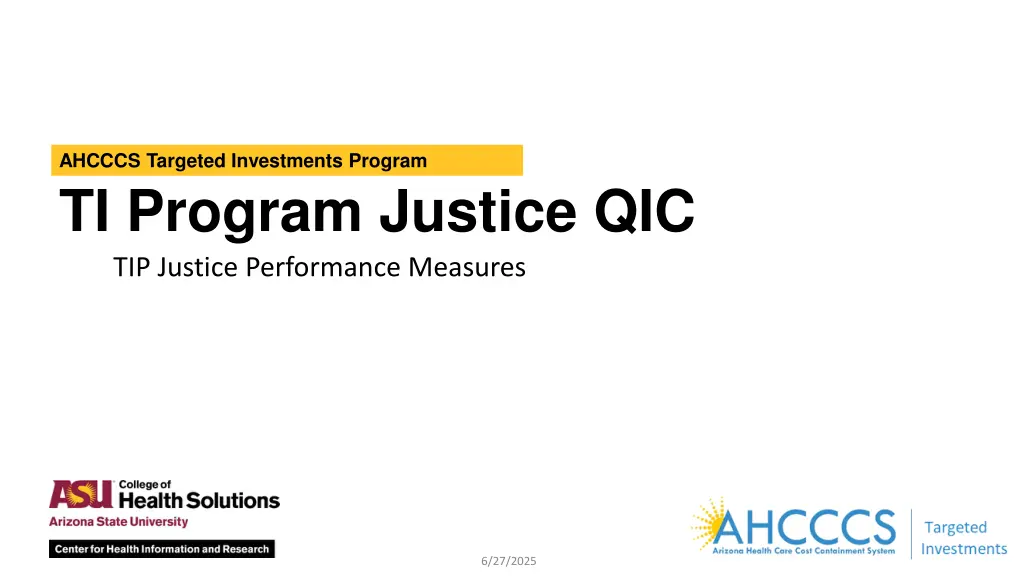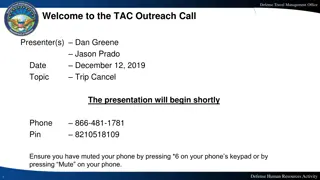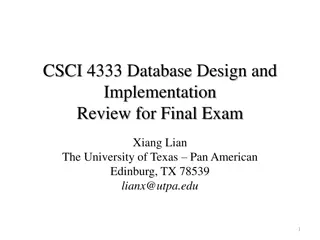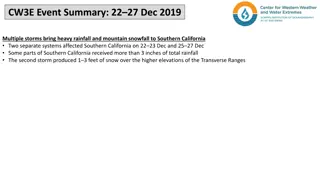
Evaluating AHCCCS Targeted Investments Program Performance
"Learn about evaluating AHCCCS Targeted Investments Program Justice Performance through evidence-based measures. Review of performance measures, concerns, modifications, and next steps discussed in a recent meeting. Focus on NCQA HEDIS criteria and innovative modifications for state-specific impact."
Download Presentation

Please find below an Image/Link to download the presentation.
The content on the website is provided AS IS for your information and personal use only. It may not be sold, licensed, or shared on other websites without obtaining consent from the author. If you encounter any issues during the download, it is possible that the publisher has removed the file from their server.
You are allowed to download the files provided on this website for personal or commercial use, subject to the condition that they are used lawfully. All files are the property of their respective owners.
The content on the website is provided AS IS for your information and personal use only. It may not be sold, licensed, or shared on other websites without obtaining consent from the author.
E N D
Presentation Transcript
AHCCCS Targeted Investments Program TI Program Justice QIC TIP Justice Performance Measures 1 6/27/2025
Agenda Agenda TOPIC TIME PRESENTER Welcome and Recap 11:00 11:05 Cameron Adams General Feedback- NCQA HEDIS Criteria 11:05 11:15 Cameron Adams Dr. Neil Robbins Overview- Criteria Modification Recommendations 11:15 11:40 Discussion 11:40 11:55 Cameron Adams Next Steps 11:55 12:00 Cameron Adams
Welcome Attendees Recorded and posted to TIPQIC.org Housekeeping
Recap Primary objective: Meaningfully evaluating TIP Justice performance with evidence-based measures Efforts to date: Identified performance measures: 7 NCQA HEDIS Identified attribution methodology: Referred members Identified concerns with measure criteria Focus groups to discuss modifications This meeting Review concerns and relevant data/ policies Summarize and discuss final modifications Discuss target setting and next steps
Recap NCQA HEDIS intended for general U.S. population Modified criteria innovative, important, and state-specific Thank you
General Feedback- NCQA HEDIS Criteria Two categories: Common Minimum enrollment vs. program goals Transparency: Individuals included in measurement Special Parole vs. Probation: Engagement and enrollment Regional challenges Target population
General Feedback- Common Concerns Minimum enrollment criteria vs. program goals Prior enrollment Care management before qualifying event Immediate engagement after release Ongoing enrollment Time to deliver F/U services vs. Return to incarceration Employment Transparency: Individuals included in measurement Referral list with referral date Rolling 24 months
General Feedback- Special Concerns Parole vs. Probation: Engagement and enrollment Suspension vs. termed enrollment ADCRR system changes Regional challenges Border towns Target population challenges SMI Criminogenic need
Overview- Measure Recommendations Conventional method Define elements Summarize concerns Explain recommendation Measure Current (HEDIS) criteria Revised criteria AOD 14/34 Enrolled 60 days before alcohol/drug abuse episode through 48 days after episode with no breaks in enrollment; 1 visit within 14 days and 2 visits within 34 days to qualify for numerator Enrolled for the full initiation/engagement period (48 days); 1 visit within 34 days to qualify for numerator SSD Enrolled for the full year, with no more than 1 gap of no longer than 45 days Enrolled for at least 180 days in the report period FUH 7/30 Enrolled on the date of hospital discharge through 30 days after hospital discharge with no breaks in enrollment N/A (Use HEDIS enrollment criteria)
Alcohol and Other Drug Abuse (AOD): Episode Definition and HEDIS Criteria Software defines start of episode as the earliest claim with an AOD diagnosis and qualifying service This claim can be either inpatient or outpatient Only one episode is recognized per member per measurement year Software then defines a 60-day lookback period and a 48-day follow-up period around the earliest qualifying claim To qualify for the denominator, members must be enrolled throughout the 60-day lookback and 48-day follow-up periods with no breaks in enrollment To qualify for the numerator, members must have at least 1 visit within 14 days of the episode (initiation of treatment), and 2 visits within 34 days of the initiation visit (engagement of treatment)
AOD: Typical Episode Timeline Oct 1, 2020 Sep 30, 2021 Measurement year Enrolled Break Enrolled Member enrollment Denominator-qualifying visits 60-day lookback 48-day follow-up AOD episode 34-day engagement 14-day initiation
Enrollment Break Definitions Breaks in enrollment can result from: Suspension Benefits changing Benefits ending These can occur during short-term jail or longer-term incarceration periods
Total referred members AOD: Denominator Using HEDIS Enrollment Criteria Met age criteria (13+) Had a qualifying alcohol/drug abuse event Total referred members Qualifying alcohol/drug abuse event Qualifying Enrollment Had qualifying enrollment Excluded due to enrollment breaks AOD Denominator 4,569 2,665 1,457 54.67% 702 48.18% Did not have prior AOD diagnosis Had AOD event >=34 days before end of report period Qualifying enrollment: enrolled 60 days prior to episode through 48 days after episode with no breaks in enrollment For Justice members with enrollment breaks: 61.1% had breaks only in the 60-day lookback 11.9% had breaks only in the 48-day follow-up 27.0% had breaks in both periods Did not have hospice services In AOD denominator 13
AOD: Concerns with Justice Population Immediate engagement post-release will result in members being excluded from the denominator Members would not meet 60-day lookback enrollment requirement Reach-in initiation of dependence treatment services will not count toward measure evaluation Earliest AOD claim after release from incarceration will count as start of episode Incarcerated, not enrolled Released, enrolled Enrollment Reach-in Post-release Denominator-qualifying visits Follow-up Lookback AOD episode
AOD: Recommendations Waive 60-day lookback requirement for denominator inclusion Pros Allows members who engage in treatment shortly after release to be included in denominator Cons None Waive 14-day initiation measure; members only required to have 1 follow- up visit within 34 days of earliest post-release visit Pros Makes use of available data (reach-in services are not available for analysis) Maximizes time to engage member for services (presumes all had reach-in initiation) Cons Strays from NCQA intent
Total referred members AOD: Estimated Denominator Using Modified Enrollment Criteria Met age criteria (13+) Had a qualifying alcohol/drug abuse event Total referred members Qualifying alcohol/drug abuse event Enrollment criteria Qualifying Enrollment AOD Denominator Had qualifying enrollment Excluded due to enrollment breaks Conventional 4,569 2,665 1,457 54.67% 702 48.18% Modified (estimate) 4,569 2,665 2,195 82.35% 1,058 48.20% Did not have prior AOD diagnosis Estimate assumes: 61.1% of events excluded due to enrollment breaks will qualify under modified criteria This is the frequency of members with breaks only in the 60-day lookback period Likelihood of moving through other algorithm steps (gray boxes) is constant Had AOD event >=34 days before end of report period Did not have hospice services In AOD denominator 16
AOD: Episode Timeline Using Modified Enrollment Criteria Oct 1, 2020 Sep 30, 2021 Measurement year Incarcerated, not enrolled Released, enrolled Member enrollment Denominator-qualifying visits Lookback Follow-up (one visit within 14 days, two within 34 days) AOD episode (conventional) Follow-up (one visit within 34 days) AOD episode (modified)
Adult Diabetes Screening (SSD): Denominator Using HEDIS Enrollment Criteria Total referred members Met age criteria (18-64) Had qualifying enrollment Excluded due to enrollment breaks Total referred members Met age criteria Qualifying enrollment SSD denominator Had diagnosis of schizophrenia/ bipolar 4,569 4,222 1,999 47.35% 253 12.66% Did not have diabetes or hospice services Qualifying enrollment: enrolled for the full year, with no more than 1 gap of no longer than 45 days Had antipsychotic medication In SSD denominator 18
SSD: Concerns with Justice Population Members may have several enrollment breaks throughout the year Re-incarceration Movement in/out of state Required number of enrolled days may be too restrictive
SSD: Enrollment breaks Among Justice members excluded from SSD measure evaluation: 75.60% had 1 break 18.02% had 2 breaks 5.02% had 3 breaks 1.35% had 4-6 breaks
SSD: Number of Enrolled Days for Excluded Members by Provider Organization Colored lines: provider organizations Black line: aggregate Dotted line indicates 180 days For each organization, at least half of the members excluded due to enrollment were enrolled for at least 180 days
SSD: Recommendation Include members enrolled for at least 180 days during the measurement year, regardless of the number of enrollment breaks Pros Increased denominator counts due to looser restrictions on enrollment 180 days is near the median number of enrolled days for each organization s members Con Less time for providers to perform diabetes screening
SSD: Denominator Using Modified Enrollment Criteria Total referred members Met age criteria (18-64) Total referred members Enrollment criteria Qualifying Enrollment Met age criteria SSD Denominator Had qualifying enrollment Excluded due to enrollment breaks Conventional 4,569 4,222 1,999 47.35% 253 12.66% Modified (estimate) Had diagnosis of schizophrenia/ bipolar 4,569 4,222 3,258 77.17% 412 12.65% Did not have diabetes or hospice services Estimates assume: 56.64% of members excluded due to enrollment breaks will qualify under modified criteria This is the frequency of members enrolled for at least 180 days Likelihood of moving through other algorithm steps (gray boxes) is constant Had antipsychotic medication In SSD denominator 23
Follow-Up After Hospitalization (FUH): Denominator Using HEDIS Enrollment Criteria Total referred members Met age criteria (6+) Had a qualifying hospitalization event Total referred members Qualifying hospitalization event Qualifying enrollment FUH denominator Had qualifying enrollment Excluded due to enrollment breaks 4,569 291 256 87.97% 249 97.27% Was discharged <=30 days before end of report period Qualifying enrollment: enrolled on the date of hospital discharge through 30 days after hospital discharge with no breaks in enrollment Did not have hospice services In FUH denominator 24
FUH: Concerns and Recommendations No concerns regarding enrollment requirements as they relate to the Justice population for this measure No changes recommended Pros Providers will have full 30-day window to perform follow-up visits Cons None
Discussion Measure Current (HEDIS) criteria Revised criteria AOD 14/34 Enrolled 60 days before alcohol/drug abuse episode through 48 days after episode with no breaks in enrollment; 1 visit within 14 days and 2 visits within 34 days to qualify for numerator Enrolled for the full initiation/engagement period (48 days); 1 visit within 34 days to qualify for numerator SSD Enrolled for the full year, with no more than 1 gap of no longer than 45 days Enrolled for at least 180 days in the report period FUH 7/30 Enrolled on the date of hospital discharge through 30 days after hospital discharge with no breaks in enrollment N/A (Use HEDIS enrollment criteria)
Next Steps Calculate with modified methodology Target setting Referral lists Individual TA TIPQIC@asu.edu TargetedInvestments@azahcccs.gov





















